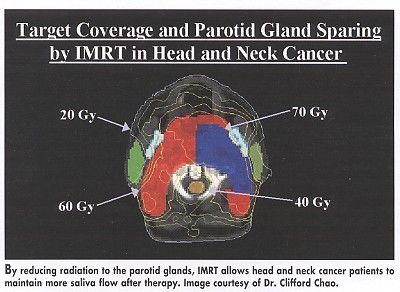IMRT Spares Salivary Function in Head & Neck Cancer Patients
BOSTON-By reducing radiation to the parotid glands, intensity modulated radiation therapy (IMRT) allows head and neck cancer patients to maintain more saliva flow after therapy. Clifford K.S. Chao, MD, of Washington University School of Medicine, St. Louis, reported the study results at the 42nd Annual Meeting of the American Society for Therapeutic Radiology and Oncology.
BOSTONBy reducing radiation to the parotid glands, intensity modulated radiation therapy (IMRT) allows head and neck cancer patients to maintain more saliva flow after therapy. Clifford K.S. Chao, MD, of Washington University School of Medicine, St. Louis, reported the study results at the 42nd Annual Meeting of the American Society for Therapeutic Radiology and Oncology.
The researchers assessed 41 patients treated with inverse planning IMRT or forward-planning 3D radiation therapy between 1997 and 1999. Only patients who received more than 50 Gy of radiation to the submandibular glands were eligible for the study.
Saliva flow at 6 weeks, 3 months, and 6 months after therapy was compared with pretreatment levels, and patients completed five questionnaires about quality of life regarding oral comfort and eating and speaking problems.
At 6 months, measurement of more saliva flow correlated with patient reports of greater ease in speaking and eating, said Dr. Chao, assistant professor of radiology and chief of the Head and Neck Service at the University’s Radiation Oncology Center.
"Dry mouth declined very substantially with IMRT, compared with conventional treatment. In conventional beam radiation, two thirds of patients still have xerostomia after a year," Dr. Chao told ONI in an interview.
The condition is an important quality-of-life issue because severe dry mouth can compromise eating and drinking functions. "It can change social behavior and patterns," Dr. Chao said. "Some patients won’t go out to eat with people."
The condition occurs when radiation aimed at head and neck tumors reaches nearby parotid gland lobes, which are located below the ear. The Washington University investigators used IMRT to sculpt radiation beams to concentrate radiation on the tumor and reduce dose volume to the surrounding tissues (see Figure). To avoid underdosing tumor targets in the parapharyngeal space, the researchers attempted to spare only the superficial lobes of the parotid glands. They re-contoured the entire parotid volume, however, to compute dose-volume histograms for their analysis.

The investigators also developed a model to examine whether functional outcome is related to radiation dose. This model showed an exponential relationship between saliva reduction and the mean radiation dose to the parotid glands (4% reduction in saliva flow per Gy of radiation to the parotid glands).
According to this model, about half of the baseline saliva flow can be maintained if the mean dose to both parotid glands is less than 16 Gy, Dr. Chao concluded. With a mean dose of 32 Gy, he said, a patient would have about one fourth the pretreatment value of saliva flowequivalent to grade 4 xerostomia.
Dr. Chao’s group has been investigating IMRT for about 4 years and has treated about 200 patients with various head and neck cancers. Based on results so far, he predicts IMRT will be the cancer treatment of the future. "The new technique provides dosimetric advantages and improves treatment outcomes," he said.